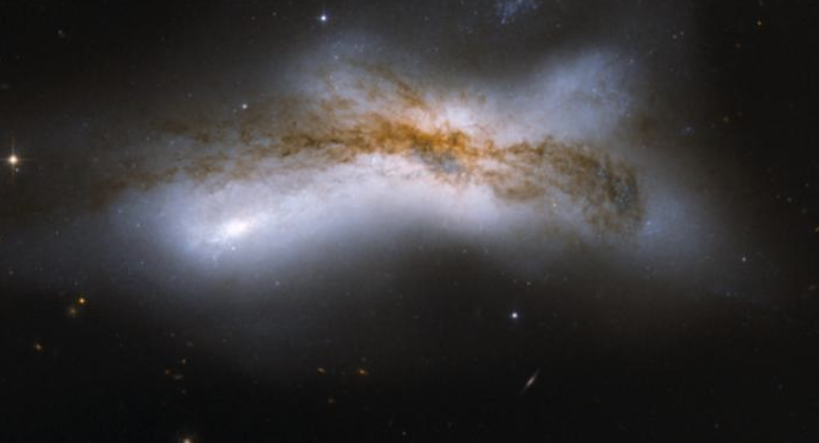One of the Universe’s Biggest Mysteries Has Been Solved, Scientists Say

Scientists have directly confirmed the location of the universe's “missing” matter for the first time, reports a study published on Monday in Nature Astronomy.
The idea that the universe must contain normal, or “baryonic,” matter that we can’t seem to find goes back to the birth of modern cosmological models. Now, a team has revealed that about 76 percent of all baryons—the ordinary particles that make up planets and stars—exist as gas hidden in the dark expanses between galaxies, known as the intergalactic medium. Fast radio bursts (FRBs), transient signals with elusive origins, illuminated the missing baryons, according to the researchers. As a bonus, they also identified the most distant FRB ever recorded, at 9.1 billion light years away, in the study.
“Measuring the ‘missing baryons’ with Fast Radio Bursts has been a major long-sought milestone for radio astronomers,” said Liam Connor, an astronomer at the Center for Astrophysics | Harvard & Smithsonian who led the study, in an email. “Until recently, we didn’t have a large-enough sample of bursts to make strong statements about where this ordinary matter was hiding.”
Under the leadership of Caltech professor Vikram Ravi, the researchers constructed the DSA-110 radio telescope—an array of over 100 dishes in the California desert—to achieve this longstanding milestone. “We built up the largest and most distant collection of localized FRBs (meaning we know their exact host galaxy and distance),” Connor explained. “This data sample, plus new algorithms, allowed us to finally make a complete baryon pie chart. There are no longer any missing wedges.”
Baryons are the building blocks of the familiar matter that makes up our bodies, stars, and galaxies, in contrast to dark matter, a mysterious substance that accounts for the vast majority of the universe’s mass. Cosmological models predict that there is much more baryonic matter than we can see in stars and galaxies, which has spurred astronomers into a decades-long search for the “missing baryons” in space.
Scientists have long assumed that most of this missing matter exists in the form of ionized gas in the IGM, but FRBs have opened a new window into these dark reaches, which can be difficult to explore with conventional observatories.
“FRBs complement and improve on past methods by their sensitivity to all the ionized gas in the Universe,” Connor said. “Past methods, which were highly informative but somewhat incomplete, could only measure hot gas near galaxies or clusters of galaxies. There was no probe that could measure the lion’s share of ordinary matter in the Universe, which it turns out is in the intergalactic medium.”
Since the first FRB was detected in 2007, thousands of similar events have been discovered, though astronomers still aren't sure what causes them. Characterized by extremely energetic radio waves that last for mere milliseconds, the bursts typically originate millions or billions of light years from our galaxy. Some repeat, and some do not. Scientists think these pyrotechnic events are fueled by massive compact objects, like neutron stars, but their exact nature and origins remain unclear.
Connor and his colleagues studied a sample of 60 FRB observations that spanned from about 12 million light years away from Earth all the way to a new record holder for distance: FRB 20230521B, located 9.1 billion light years away. With the help of these cosmic searchlights, the team was able to make a new precise measurement of the density of baryonic matter across the cosmic web, which is a network of large-scale structures that spans the universe. The results matched up with cosmological predictions that most of the missing baryons would be blown out into the IGM by “feedback” generated within galaxies. About 15 percent is present in structures that surround galaxies, called halos, and a small remainder makes up stars and other celestial bodies.
“It really felt like I was going in blind without a strong prior either way,” Connor said. “If all of the missing baryons were hiding in galaxy halos and the IGM were gas-poor, that would be surprising in its own way. If, as we discovered, the baryons had mostly been blown into the space between galaxies, that would also be remarkable because that would require strong astrophysical feedback and violent processes during galaxy formation.”
“Now, looking back on the result, it’s kind of satisfying that our data agrees with modern cosmological simulations with strong ‘feedback’ and agrees with the early Universe values of the total abundance of normal matter,” he continued. “Sometimes it’s nice to have some concordance.”
The new measurement might alleviate the so-called sigma-8 tension, which is a discrepancy between the overall “clumpiness” of matter in the universe when measured using the cosmic microwave background, which is the oldest light in the cosmos, compared with using modern maps of galaxies and clusters.
“One explanation for this disagreement is that our standard model of cosmology is broken, and we need exotic new physics,” Connor said. “Another explanation is that today’s Universe appears smooth because the baryons have been sloshed around by feedback.”
“Our FRB measurement suggests the baryon cosmic web is relatively smooth, homogenized by astrophysical processes in galaxies (feedback),” he continued. “This would explain the S8 tension without exotic new physics. If that’s the case, then I think the broader lesson is that we really need to pin down these pesky baryons, which have previously been very difficult to measure directly.”
To that end, Connor is optimistic that more answers to these cosmic riddles are coming down the pike.
“The future is looking bright for the field of FRB cosmology,” he said. “We are in the process of building enormous radio telescope arrays that could find tens of thousands of localized FRBs each year,” including the upcoming DSA-2000.
“My colleagues and I think of our work as baby steps towards the bigger goal of fully mapping the ordinary, baryonic matter throughout the whole Universe,” he concluded.






